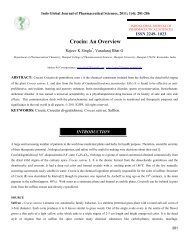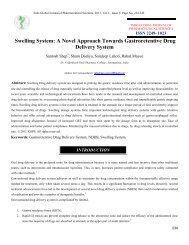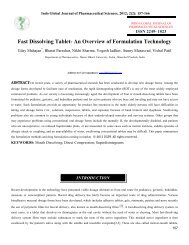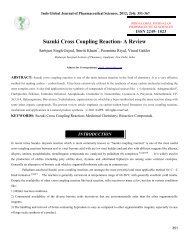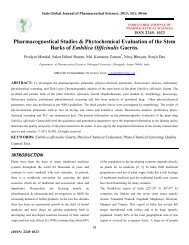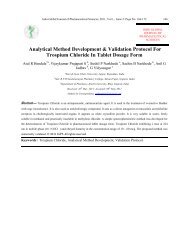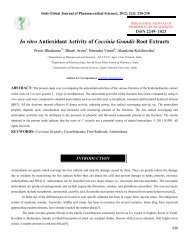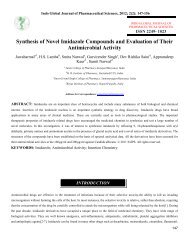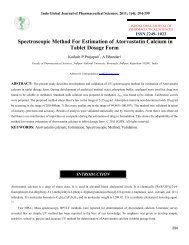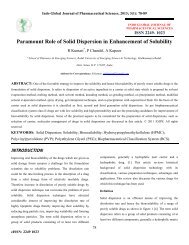Scientific Investigation of Antitrypanosomal Activity of Crateva ...
Scientific Investigation of Antitrypanosomal Activity of Crateva ...
Scientific Investigation of Antitrypanosomal Activity of Crateva ...
- No tags were found...
You also want an ePaper? Increase the reach of your titles
YUMPU automatically turns print PDFs into web optimized ePapers that Google loves.
Indo Global Journal <strong>of</strong> Pharmaceutical Sciences, 2012; 2(3): 226-229<strong>Scientific</strong> <strong>Investigation</strong> <strong>of</strong> <strong>Antitrypanosomal</strong> <strong>Activity</strong> <strong>of</strong> <strong>Crateva</strong>Adansonii DC Leaves ExtractsNgozichukwuka Peace Igoli a , Alexander I Gray a , Carol J Clements a , John O Igoli *a ,Nzekwe U b , Rajeev K Singla caNatural Product Laboratories, SIPBS, University <strong>of</strong> Strathclyde, 161 Cathedral Street, Glasgow G4 0RE, ScotlandbDepartment <strong>of</strong> Botany, University <strong>of</strong> Nigeria, Nsukka, NigeriaINDO GLOBAL JOURNAL OFPHARMACEUTICAL SCIENCESISSN 2249- 1023cDivision <strong>of</strong> Biotechnology, Netaji Subhas Institute <strong>of</strong> Technology, Azad Hind Fauz Marg, Sector-3, Dwarka, New Delhi-110078, IndiaAddress for Correspondance: john.igoli@strath.ac.ukABSTRACT: <strong>Crateva</strong> adansonii DC is used in traditional medicines in the West <strong>of</strong> Africa. The crude hexane (CAN-1) andethyl acetate (CAN-2) extracts were evaluated for their in vitro bioactivity against African trypanosome Trypanosoma bruceibrucei (S427) blood stream forms. The crude extracts showed moderate anti-trypanosomal activity (MIC 12.5µg/ml). Werecommend its use either alone or in combination with other natural/semi-synthetic/synthetic drugs for the treatment <strong>of</strong> HumanAfrican Trypanosomiasis. © 2011 IGJPS. All rights reserved.KEYWORDS: <strong>Crateva</strong> adansonii DC; Anti-trypanosomal activity; T. brucei; Medicinal Plants; Tsetse Fly;Sleeping Sickness; Human African Trypanosomiasis.INTRODUCTIONHerbal products are gaining progressively attention due to less toxicity and high efficacy against free radical mediated diseases. Atpresent, approximately 25% <strong>of</strong> drugs in modern pharmacopoeia were derived from plants (phytomedicines) and many others weresynthetic analogues built on the prototype compounds isolated from plants [1-4].<strong>Crateva</strong> adansonii DC, also known as <strong>Crateva</strong> religiosa or sacred garlic pear, belongs to family Capparaceae is in highdemand, especially its leaves for the treatment <strong>of</strong> ear infections. The bark is widely used for stomach troubles and held to have tonicproperties. In Senegal the roots figure in several treatments for syphyilis, jaundice and yellow fevers[5]. Ayodeji and coworkersclaimed the antimicrobial properties <strong>of</strong> its leaves[6]. Organic extract(dichloromethane & methanol, 1:1) <strong>of</strong> C. adanosonii DC seedshad been evaluated for their bioactivity against brine shrimp found to have very high activity. Two phytoconstituents had also beenisolated and identified as oleanolic acid(Figure 1) and 4-epi-hederagenin(Figure 1). When done the comparative analysis, oleanolicacid have LC 50 2.51 µg/ml as compared to the standard cycloheximide(LC 50 is 40 µg/ml)[7].226
Indo Global Journal <strong>of</strong> Pharmaceutical Sciences, 2012; 2(3): 226-229Figure 1 Structure <strong>of</strong> Oleanolic Acid(1) & 4-epi-hederagenin(2)Unlike other communicable diseases that receive a high level <strong>of</strong> attention from health systems, a group <strong>of</strong> parasitic andinfectious diseases has been characterized by historically low investment by the pharmaceutical industry[8,9]. Human Africantrypanosomiasis, also known as sleeping sickness, is a vector borne disease where the vector is tsetse fly. Sleeping sickness threatensmillions <strong>of</strong> people in 36 countries in sub-Saharan Africa[10]. Till date, there is no information related to the anti-trypanosomal activity<strong>of</strong> this handsome tree, C. adansonii DC.The aim <strong>of</strong> the present study was to investigate the anti-trypanosomal activity <strong>of</strong> <strong>Crateva</strong> adansonii in order to evaluate itsmedicinal value and to point to an easily accessible source <strong>of</strong> natural anti-trypanosomals that could be used as possible replacement <strong>of</strong>existing allopathic medicines.MATERIALS & METHODSCollection <strong>of</strong> MaterialFresh leaves <strong>of</strong> C. adansonii were harvested from Nsukka, Enugu State <strong>of</strong> Nigeria in August 2011, sun-dried and ground to powder.The plant was authenticated by the Department <strong>of</strong> Botany <strong>of</strong> the University <strong>of</strong> Nigeria, Nsukka where a voucher specimen No 1152was deposited in the University herbarium.Preparation <strong>of</strong> SamplesFinely grounded leaves (501.08g) were extracted successively with hexane and ethyl acetate in a soxhlet extractor to obtain11.83g(CAN-1) and 14.20g(CAN-2) <strong>of</strong> crude extracts respectively.Antitrypanosmal <strong>Activity</strong>A modification <strong>of</strong> the microplate Alamar blue assay to determine drug sensitivity <strong>of</strong> African trypanosomes in vitro according to Raj &coworkers, 1997 was used[11]. Stock solutions <strong>of</strong> plant extracts were prepared as 10mg/ml in DMSO and serially diluted in HMI-9medium, the negative control for MIC determination. 10µM Suramin was the positive control.227
Indo Global Journal <strong>of</strong> Pharmaceutical Sciences, 2012; 2(3): 226-229Trypanosomes blood forms used were Trypanosoma brucei brucei S427 and the concentrations <strong>of</strong> trypanosomes were 2 - 3 x10 4trypanosomes/ml. Incubation was at 37ºC, 5% CO 2 with a humidified atmosphere for 48 hours for three replicates made. Alamar bluewas used and fluorescence determined on a Wallac Victor microplate reader in fluorescence mode (Excitation 530nm; Emission590nm).RESULTS & DISCUSSIONFigure 2Hexane extract (CAN-1) and ethyl acetate extract(CAN-2) <strong>of</strong> C. adansonii DC leaves were evaluated in vitro against Africantrypanosome blood forms Trypanosoma brucei brucei S427(Figure 2). Both CAN-1 and CAN-2 have an MIC value <strong>of</strong> 12.5 µg/ml,comparable to that <strong>of</strong> standard Suramin. Oleanolic acid reported to have anti-trypanosomal activity[12], could be attributablephytoconstituent for the activity <strong>of</strong> CAN-1 and CAN-2 against T. brucei brucei blood forms. This study leads us to conclude that C.adansonii DC can certainly replace the modern medicines for the treatment <strong>of</strong> trypanosomiasis. Further isolation and characterization<strong>of</strong> the responsible constituents from these extracts <strong>of</strong> C. adansonii DC is desirable.ACKNOWLEDGEMENTThe authors are grateful to the Department <strong>of</strong> Botany <strong>of</strong> the University <strong>of</strong> Nigeria, Nsukka for providing the material and help us inauthentication <strong>of</strong> this plant. Author Rajeev K Singla express its gratitude to Department <strong>of</strong> Science, Government <strong>of</strong> India for providingYoung Scientist’s Fellowship(SR/FT/LS-149/2011).228
Indo Global Journal <strong>of</strong> Pharmaceutical Sciences, 2012; 2(3): 226-229REFERENCES1. Rajeev K Singla, Hitesh Jagani. <strong>Investigation</strong> <strong>of</strong> antimicrobial effect <strong>of</strong> dry distilled extract <strong>of</strong> Cocos nucifera Linn. endocarp.WebmedCentral PHARMACEUTICAL SCIENCES, 2012; 3(8): WMC003671.2. T. H. Khan, S. Sultana. Antioxidant and Hepatoprotective potential <strong>of</strong> Soy Is<strong>of</strong>lavones against CCl4 induced oxidative stress and earlytumor events. Indo Global Journal <strong>of</strong> Pharmaceutical Sciences, 2011; 1(1): 39-56.3. Rajeev K Singla. Review on the pharmacological properties <strong>of</strong> Cocos Nucifera endocarp. WebmedCentral PHARMACEUTICALSCIENCES, 2012; 3(5): WMC003413.4. C C Barua, A Talukdar, S A Begum, A K Handique, G K Handique, J D Roy, B Buragohain. Impact <strong>of</strong> Achyranthes aspera L. on proteinpr<strong>of</strong>ile in impaired wound models. Indo Global Journal <strong>of</strong> Pharmaceutical Sciences. 2011; 1(1): 13-24.5. H. M. Burkill. The useful plants <strong>of</strong> West Tropical Africa. Kew Publishing, 1985, Vol 1. ISBN 094764301X.6. Agboke Ayodeji A., Attama Anthony A., Momoh Mumuni A. Evaluation <strong>of</strong> the antimicrobial properties <strong>of</strong> crude extract <strong>of</strong> Cryptolepissanguinolenta and <strong>Crateva</strong> adansonii leaves and their interactions. Journal <strong>of</strong> Applied Pharmaceutical Science. 2011; 1(10): 85-89.7. C. L. Cantrell, M. A. Berhow, B. S. Phillips, S. M. Duval, D. Weisleder, S. F. Vaughn. Bioactive crude plant seed extracts from theNCAUR oilseed repository. Phytomedicine. 2003; 10: 325-333.8. Gabrieli L. Parrilha, Roberta P. Dias, Willian R. Rocha, Isolda C. Mendes, Diego Benitez, Javier Varela, Hugo Cerecetto, MercedesGonzalez, Cristiane M. L. Melo, Juliana K. A. L. Neves, Valeria R. A. Periera, Heloisa Beraldo. 2-Acetylpyridine- and 2-benzoylpyridinederivedthiosemicarbazones and their antimony(III) complexes exhibit high anti-trypanosomal activity. Polyhedron. 2012; 31: 614-621.9. World Health Organization, 2009. 10 Facts on neglected tropical diseases web page. Available from:http://www.who.int/features/factfiles/neglected_tropical_diseases/en/index.html (accessed July 2010).10. World Health Organization, 2012. Human African trypanosomiasis(sleeping sickness). Available from:http://www.who.int/mediacentre/factsheets/fs259/en/ (Accessed Sept, 2012).11. B Raz, M Iten, Y Grether-Buhler, R Kaminsky, R Brun. The Alamar Blue® assay to determine drug sensitivity <strong>of</strong> African trypanosomes(T.b. rhodesiense and T. b. gambiense) in vitro. Acta Tropica. 1997; 68(2): 139-147.12. Juan Diego Maya, Bruce K. Cassels, Patricio Iturriaga-Vasquez, Jorge Ferreira, Mario Faundez, Norbel Galanti, Arturo Ferreira, AntonioMorello. Mode <strong>of</strong> action <strong>of</strong> natural and synthetic drugs against Trypanosoma cruzi and their interaction with the mammalian host.Comparative Biochemistry and Physiology. 2007; 146: 601-620.Indo Global Journal <strong>of</strong> Pharmaceutical Sciences( ISSN 2249 1023 ; CODEN-IGJPAI) indexed and abstracted in EMBASE(Elsevier), SCIRUS(Elsevier),Chemical Abstract Services(CAS), American Chemical Society(ACS), IndexCopernicus, EBSCO, DOAJ, Google Scholar and many more. For further details,visit http://iglobaljournal.com229





